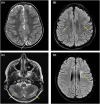Developmental and epileptic encephalopathies after successful treatment of pediatric ALL: A case series and review of literature
- PMID: 39258473
- PMCID: PMC11651377
- DOI: 10.1002/epd2.20280
Developmental and epileptic encephalopathies after successful treatment of pediatric ALL: A case series and review of literature
Abstract
Successful treatment of acute lymphoblastic leukemia (ALL) requires multiagent chemotherapy regimens and central nervous system prophylaxis, including intrathecal methotrexate. Although acute symptomatic seizures can occur during ALL treatment, epilepsy is less common. Furthermore, drug resistant epilepsy (DRE) is rare, presenting with two phenotypes: focal epilepsy, such as temporal lobe, or epileptic encephalopathies (EE), such as Lennox-Gastaut syndrome (LGS). For ALL survivors, the development of DRE has significant impact on morbidity, mortality, and quality of life. We describe four patients with ALL remission, who developed EEs, of which 3 had LGS. Mean age at ALL diagnosis was 1.9 years; range 1.1-2.5 years. All, but one, had normal development prior to ALL. No patient had CNS leukemic involvement. All patients received CNS prophylaxis with intrathecal methotrexate, without cranial radiotherapy. Three had symptomatic methotrexate neurotoxicity during treatment. The mean age at first seizure was 5.6 years; range 3.9-7.5 years, with a mean latency of 3.7 years from ALL diagnosis. All patients developed drug resistant EEs, moderate intellectual disability, and neuropsychiatric co-morbidities. Two patients had a minimal response to corpus callosotomy (CC), and one did not respond the ketogenic diet. Successful treatment of childhood ALL is rarely associated with the development of DRE and EEs. Young age at ALL diagnosis (<3 years) may be a predisposing factor. Palliative treatments, including ketogenic diet and CC have limited benefit in these patients. Individual genetic susceptibility to MTX toxicity is likely related to epileptogenesis, and further research is required for epilepsy biomarkers.
Keywords: Lennox–Gastaut syndrome; epileptic encephalopathy (not otherwise classified); spasms (epileptic); tonic seizure: atonic seizure.
© 2024 The Author(s). Epileptic Disorders published by Wiley Periodicals LLC on behalf of International League Against Epilepsy.
Conflict of interest statement
The Authors declare that there is no conflict of interest.
Figures


References
-
- Howlader N, Noone A‐M, Krapcho M, Garshell J, Miller D, Altekruse SF, et al. SEER cancer statistics review, 1975–2010. Bethesda MD: National Cancer Institute; 2013. https://seer.cancer.gov/archive/csr/1975_2010/results_merged/sect_29_chi...
-
- Hamamoto K, Oriuchi N, Kanazawa T, Higuchi T, Endo K. Mesial temporal sclerosis associated with methotrexate‐induced leukoencephalopathy. Pediatr Neurol. 2009;40:306–309. - PubMed
Publication types
MeSH terms
Substances
Supplementary concepts
LinkOut - more resources
Full Text Sources

